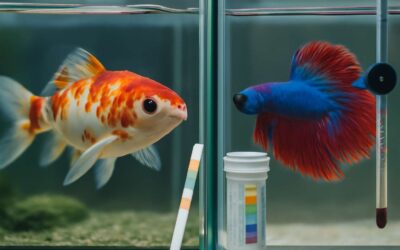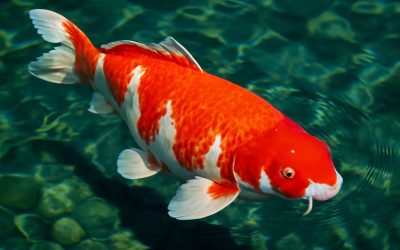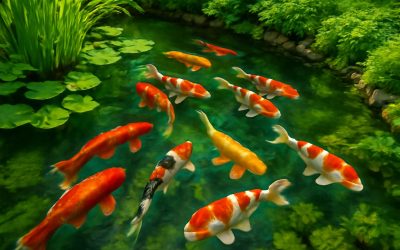Common Koi Diseases and Their Symptoms
Infectious Diseases in Koi
In the vibrant world of koi keeping, understanding koi health problems is essential to maintaining a thriving pond. Infectious diseases in koi can spread rapidly, turning a serene aquatic oasis into a battleground for health. Recognizing symptoms early can make all the difference in preserving these majestic fish. Common signs of illness include lethargy, abnormal swimming patterns, and visible lesions or spots. These symptoms often signal underlying issues that require prompt attention.
Among the most prevalent infectious diseases in koi are bacterial infections, which can lead to ulcers and fin rot, and parasitic invasions like Ichthyophthirius multifiliis, known for its distinctive white spots. Fungal infections may manifest as cotton-like growths on the koi’s body, further complicating health problems. It’s crucial for koi enthusiasts in South Africa to stay vigilant, as environmental stressors and water quality often exacerbate these issues. Regular monitoring and early diagnosis are the best defenses against the devastating effects of koi health problems.
Non-Infectious Conditions
While infectious diseases often dominate discussions on koi health problems, non-infectious conditions can be equally devastating if overlooked. These issues typically stem from environmental stressors, poor water quality, or nutritional deficiencies, subtly undermining the koi’s vitality over time. Recognizing the symptoms early is vital to prevent long-term health deterioration.
One common non-infectious problem is *fin erosion*, often caused by poor water conditions or abrasive substrates. Koi may exhibit frayed fins, which can become infected if not addressed promptly. Another prevalent issue is *swim bladder disorder*, leading to abnormal buoyancy and difficulty maintaining a normal position in the water. This condition can result from dietary imbalances or sudden water temperature changes, common in South African pond environments.
Understanding these non-infectious koi health problems requires keen observation and a comprehensive approach. Regular water testing, balanced nutrition, and attentive pond maintenance form the cornerstone of prevention. Sometimes, the root causes are subtle, lurking beneath the surface, emphasizing the importance of a holistic perspective in koi care.
- Water quality fluctuations
- Nutritional deficiencies
- Environmental stressors
By maintaining a vigilant eye on these factors, koi enthusiasts can better navigate the complex landscape of koi health problems, ensuring their fish thrive in harmony with their aquatic environment. After all, a healthy koi is a reflection of a well-balanced ecosystem—an ongoing dance between nature and nurture.
Environmental Factors Affecting Koi Health
Water Quality Issues
The health of koi fish is intricately tied to their environment, and water quality issues are often the silent culprits behind many koi health problems. When water becomes contaminated with excess nutrients, toxins, or debris, it creates a hostile environment that stresses the fish and weakens their immune system. This stress can pave the way for a cascade of health issues, from fin rot to ulcers, making it vital for pond keepers to vigilantly monitor water parameters.
Environmental factors such as fluctuating pH levels, oxygen depletion, and ammonia spikes can all have a profound impact on koi health problems. A pond’s ecosystem is delicate — even minor imbalances can cause significant distress. Regular testing of water quality, along with proper filtration and aeration, helps maintain a stable environment, preventing the onset of many issues that threaten these vibrant creatures.
Water Temperature Fluctuations
Water temperature fluctuations are a subtle yet potent factor influencing koi health problems. Unlike the steady warmth of a well-maintained pond, sudden drops or spikes in temperature can jolt koi into stress, impairing their immune defenses. In South Africa’s varying climate, these temperature swings are especially prevalent, making vigilant monitoring crucial. Such fluctuations can disrupt metabolic processes, leading to issues like lethargy, reduced appetite, and increased susceptibility to infections.
Koi are particularly sensitive to temperature changes between 10°C and 25°C. Rapid shifts within this range can unsettle their delicate physiology. For instance, a sudden cold snap might slow down their metabolism, while a heatwave could cause oxygen depletion in the pond. To mitigate these risks, pond keepers should consider implementing temperature control measures, such as thermal covers or aeration systems designed to stabilize water temperatures. Remember, even minor temperature fluctuations can trigger or exacerbate koi health problems, making consistent monitoring an essential part of pond management.
Tank and Pond Conditions
In the vast and ever-changing realm of pond ecosystems, environmental factors wield a silent but potent influence over koi health problems. The delicate balance of water chemistry, nutrient levels, and light exposure can turn from harmony to chaos in the blink of an eye. South Africa’s temperamental climate, with its scorching summers and unpredictable cold snaps, adds an extra layer of complexity to maintaining optimal pond conditions. These fluctuations can subtly erode the resilience of koi, making them vulnerable to a host of health issues that often go unnoticed until they escalate.
Among the critical environmental factors affecting koi health are pond conditions that promote stability and natural balance. Overcrowding, for example, can lead to oxygen depletion and increased waste buildup, fostering an environment ripe for disease. Conversely, a pristine pond with balanced pH, appropriate filtration, and consistent water levels creates a haven where koi can thrive. When these elements falter, koi become prone to stress-induced ailments, which can spiral into more serious health problems. Recognizing the importance of a harmonious aquatic environment is essential for safeguarding koi from the unseen threats lurking within their habitat.
Nutritional Deficiencies and Diet-Related Problems
Signs of Poor Nutrition
Many koi owners overlook the importance of proper nutrition, yet nutritional deficiencies are a silent threat contributing to numerous koi health problems. When their diet lacks essential vitamins and minerals, koi can exhibit a range of troubling signs, from dull coloration to lethargy. These symptoms often go unnoticed until more severe issues arise. A balanced diet is vital to maintaining their immune system and overall vitality.
Signs of poor nutrition can manifest subtly but significantly impact koi well-being. Common indicators include flaky skin, frayed fins, abnormal swimming patterns, and a decreased appetite. These symptoms suggest the koi’s body is struggling to absorb the necessary nutrients, making them more vulnerable to disease. Ensuring a diet rich in high-quality pellets, fresh vegetables, and occasional treats can help prevent these issues.
To identify and rectify diet-related problems early, consider a simple nutritional checklist:
- Observe koi’s coloration and activity levels
- Check for visible fin and skin health
- Monitor changes in appetite or behavior
Tackling koi health problems linked to diet requires vigilance and knowledge, but understanding the signs of poor nutrition is a crucial first step toward keeping your pond healthy and vibrant.
Balanced Diet for Koi
Nutritional deficiencies are a sneaky culprit behind many koi health problems, often lurking unnoticed until they cause visible chaos. A diet lacking essential vitamins and minerals can turn a vibrant koi into a dull, lethargic shadow of its former self. It’s as if poor nutrition whispers, “Hey, I’m your silent health assassin,” while your koi’s colors fade and their activity wanes.
Balancing a koi’s diet is crucial to prevent these issues from spiraling out of control. A diet that includes high-quality pellets, fresh vegetables, and occasional treats provides the nutrients necessary for immune support and overall vitality. To keep an eye on your pond’s star pupils, consider this simple nutritional checklist:
- Observe koi’s coloration and activity levels
- Check for visible fin and skin health
- Monitor changes in appetite or behavior
Remember, neglecting proper nutrition can turn a minor inconvenience into a full-blown crisis—so stay vigilant. After all, good food is the cornerstone of healthy koi and a thriving pond ecosystem, helping you dodge those pesky koi health problems with a bit of preventative flair.
Preventive Measures for Maintaining Koi Health
Regular Health Monitoring
Maintaining the vitality of koi fish requires more than just water quality and nutrition; it hinges on vigilant, ongoing health monitoring. In the vibrant waters of South Africa, where koi health problems can turn from minor nuisances to full-blown crises, establishing a routine check-up is essential. Regular observation allows aquarists to catch early signs of distress, preventing potentially devastating consequences for these regal creatures.
An effective way to stay ahead of koi health problems is to develop a systematic approach to monitoring. Keep an eye out for unusual swimming patterns, discoloration, or abnormal behavior—these are often the first whispers of trouble. Incorporating a simple log to record daily observations can reveal patterns that might otherwise go unnoticed. Remember, early detection is the secret to preserving the health and beauty of your koi pond or tank.
To enhance your vigilance, consider implementing a schedule of routine health assessments that include checking for external parasites, examining fins, and observing feeding responses. Utilizing tools such as magnifying glasses or even digital cameras can help scrutinize subtle changes. Ultimately, these practices transform routine maintenance into a proactive shield against koi health problems, ensuring your aquatic friends thrive amidst the lush landscapes of South Africa.
Quarantine Procedures
Preventive measures are the cornerstone of maintaining the pristine health of koi in South Africa’s lush aquatic landscapes. Quarantine procedures, in particular, serve as a vital barrier against koi health problems that can swiftly escalate into widespread affliction. When new koi are introduced, isolating them for a period allows for meticulous observation, preventing the inadvertent spread of hidden ailments. This simple step preserves the delicate balance of your pond ecosystem and safeguards your prized koi from unseen threats.
Implementing a structured quarantine protocol involves more than just separation; it requires regular inspection and careful documentation. During this period, monitor for subtle signs of distress, such as irregular swimming or minor discoloration—clues often overlooked but crucial in early detection. To streamline this process, consider establishing a routine checklist that includes checking for external parasites, inspecting fins, and observing feeding behavior. This proactive vigilance transforms potential crises into manageable challenges, ensuring your koi remain vibrant and resilient amidst South Africa’s diverse aquatic environments.
Proper Pond Maintenance
Proper pond maintenance is the backbone of koi health and resilience. In South Africa’s varied climate, neglecting routine upkeep can quickly lead to water quality issues and exacerbate koi health problems. Clean, well-oxygenated water is essential to prevent stress and disease. Regularly removing debris, performing partial water changes, and checking filtration systems help maintain a stable environment for your koi.
Beyond water quality, controlling algae growth and preventing the buildup of toxins can significantly reduce the risk of koi health problems. Consider installing automatic feeders and monitoring feeding routines, as overfeeding can pollute water and promote disease. A balanced pond ecosystem not only supports vibrant koi but also acts as a natural barrier against many common health issues. When these elements are neglected, koi become more susceptible to infections, parasites, and other health complications—making vigilant pond maintenance a key strategy for keeping your koi thriving in South Africa’s diverse aquatic landscapes.
Treatment Options for Common Koi Health Problems
Medications and Remedies
When it comes to koi health problems, swift and effective treatment can mean the difference between a thriving pond and a heartbreaking loss. Many koi owners find that a combination of medications and natural remedies offers the best chance for recovery. For bacterial infections, antibiotics such as oxytetracycline or erythromycin are often prescribed, but always under the guidance of a professional. Parasite infestations, which are common in koi ponds, can be tackled with antiparasitic treatments like formalin or praziquantel. Additionally, incorporating herbal remedies such as garlic extract can bolster the koi’s immune system, helping to fight off persistent health problems.
In cases of fungal infections, antifungal agents like malachite green or potassium permanganate are effective. It’s crucial to regularly monitor koi for early signs of disease and to act promptly, as delayed treatment can exacerbate koi health problems significantly. Furthermore, maintaining a clean environment with proper pond aeration and water quality management enhances the efficacy of any treatment plan. Remember, the key is a balanced approach—combining medication with improved pond conditions—to restore your koi’s health and prevent future koi health problems from taking hold.
When to Seek Professional Help
When it comes to koi health problems, timely intervention can turn the tide from despair to delight. While some issues demand nothing short of professional expertise, others respond beautifully to a well-chosen treatment plan. Recognizing the right moment to seek specialist help can be the difference between a resilient koi and a pond full of sorrow. Often, persistent symptoms such as abnormal swimming, visible lesions, or rapid gill movement signal that your koi’s health is in jeopardy and warrants expert consultation.
In more straightforward situations, targeted treatments can do wonders. For bacterial infections, antibiotics like oxytetracycline and erythromycin are your allies—ideally administered under the guidance of a seasoned veterinarian or aquatic specialist. Parasite infestations, which are alarmingly common, respond well to treatments like formalin or praziquantel, effectively restoring balance. Incorporating herbal remedies such as garlic extract can also serve as a natural immune booster, providing a gentle yet potent line of defense against recurring koi health problems.
- If symptoms persist despite treatment, or if koi show signs of severe distress, seeking professional help becomes imperative.
- In cases of unexplained lethargy, loss of appetite, or unusual growths, a comprehensive diagnosis from an aquatic veterinarian ensures no underlying issue is overlooked.
Monitoring water quality remains the cornerstone of preventive care. When koi health problems arise, it’s often a sign that environmental conditions have tipped the balance. Acting swiftly—whether through medication, improved pond conditions, or expert advice—preserves the vitality of your aquatic friends and keeps your pond a serene sanctuary rather than a battleground of maladies.



0 Comments